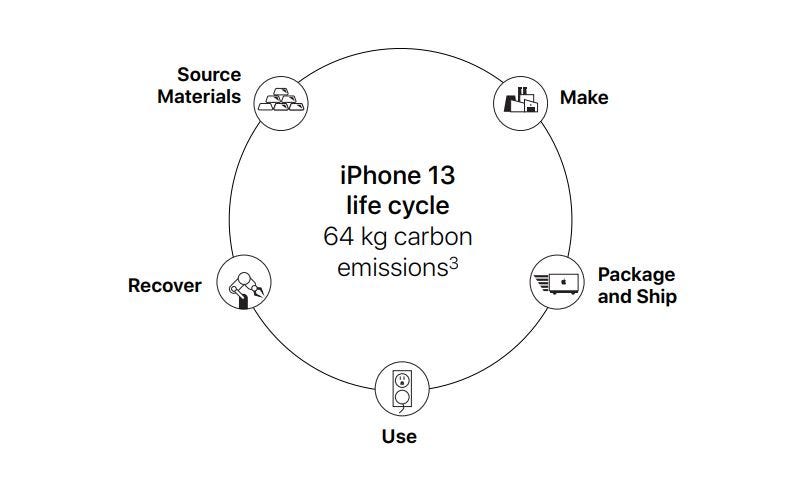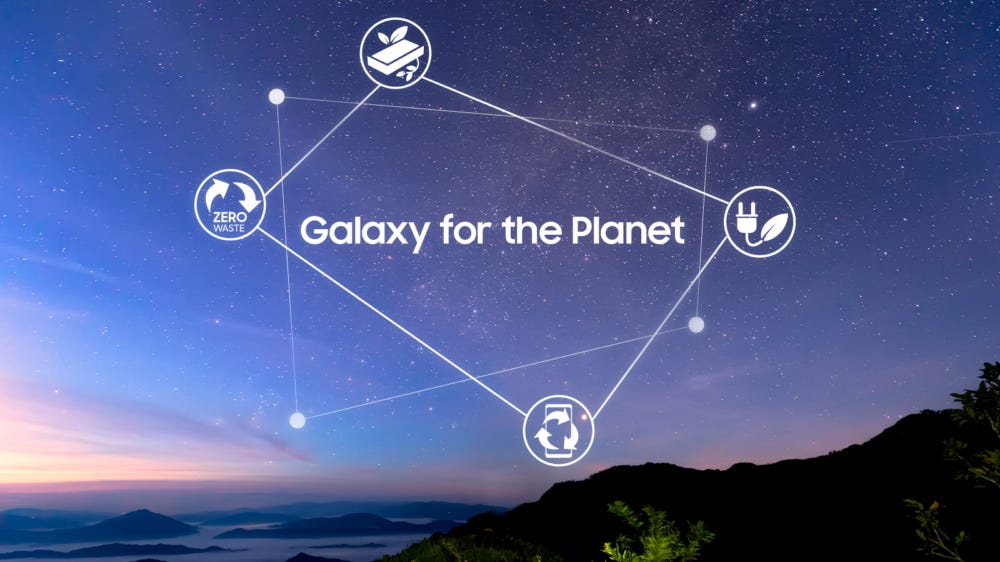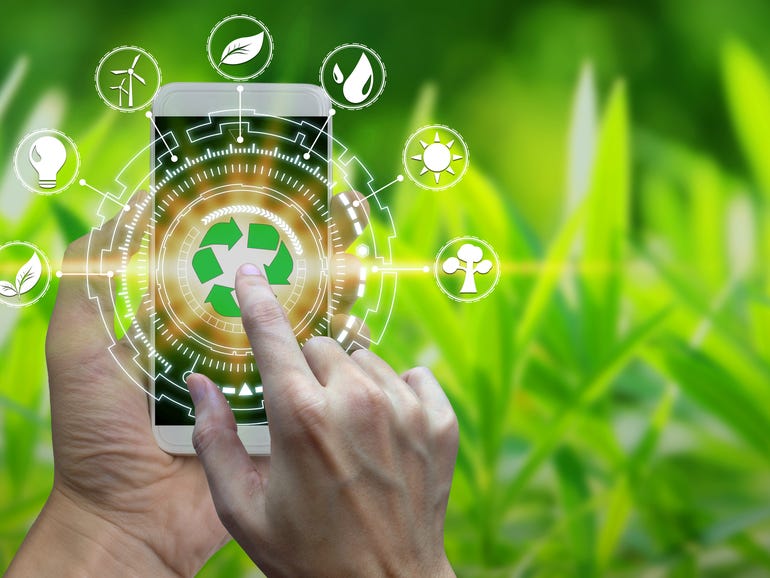Most eco-friendly smartphone? Apple vs Samsung in the race against e-waste
Electronic waste (e-waste) is one of the biggest environmental issues currently plaguing our planet. The metals, toxic chemicals, and carbon production spurred by both the creation of, and subsequent disposal of, our numerous electronic devices is an issue that needs to be dealt with as soon as possible.
Also: Our old devices are creating a mountain of e-waste. And it’s getting a lot bigger
As one of the most productive areas of electronics (and thus e-waste) today, smartphones sit at the center of ongoing efforts to reduce the environmental impact of our thirst for more and more technology in our personal and professional lives. Most of the top manufacturers in the world already have efforts underway to curtail, or even reverse, the environmental impacts of their respective smartphone production operations.
We’re going to take a macro-level look at two of the largest smartphone makers in the world today: Apple and Samsung. Both of the perennial rivals have numerous ongoing initiatives designed to reduce or eliminate the harm creating smartphones can do to our planet. Let’s take a deeper dive into exactly what those specific initiatives entail, how successful they might be, and how they’re being applied to the latest and greatest models from both companies.

Apple
Apple
Apple is quite proud of the fact that it has reached carbon neutrality for part of its operations, but it notes that it will take until 2030 for all of its products to be fully carbon neutral across its manufacturing infrastructure. Until then, the company continues making progress in its efforts to reduce carbon emissions across each subsequent generation. For example, the
iPhone 13’s
emissions fell to between 64 Kg CO2e and 71 Kg CO2e (depending on the storage size in question), down from the
iPhone 12’s
range of 68 Kg CO2e to 80 Kg CO2e for comparable models.
While it works on continuing to shrink those figures, Apple has chosen to focus on five tentpole factors surrounding each product, including the iPhone:
-
How it’s designed.
-
How it’s made.
-
How it’s shipped.
-
How it’s used.
-
How it’s recycled.
Let’s use Apple’s own priorities to inform a deeper look at its ongoing efforts and how they impact its smartphone line.
How it’s designed
Apple’s eco-conscious design philosophy focuses primarily on one thing: reducing the amount of carbon that will be generated over a device’s lifetime from the initial design phase. This includes measures such as using recycled and hydro-smelted aluminum in its
MacBooks
, iPads, and other devices, a move which Apple claims to have reduced the carbon footprint of its aluminum based production processes by 72% since 2015. Unfortunately, the iPhone line has yet to benefit from this particular measure.
Where Apple does tout its progress with iPhones specifically is in their charging protocols. According to the company, its iPhone 12 generation used 53% less power to charge its built-in cell than the US Department of Energy requirements for battery charger systems. The iPhone 13 has since bumped that up to 54% less. The increased efficiency means that less of the power generated for use in charging iPhones gets wasted, resulting in lower demand and fewer associated carbon emissions.
How it’s made
This is an area where Apple’s latest phone shines. The iPhone leans heavily on recycled materials. Of the materials in Apple’s latest flagship, all rare earth, tungsten, tin, and, for the first time, gold components being used are 100% recycled. It’s also using 35% recycled plastic in this year’s design.
How it’s shipped
It’s been several generations since Apple ceased including a charger with the iPhone. This has allowed the company to shrink the packaging considerably, resulting in a smaller box with less included plastic. Even the outer shrink wrap has been left behind in favor of a couple of tiny plastic strips that seal either end.
To encase the iPhone 13, Apple used 95% fiber-based packaging materials to help further reduce plastic waste. That fiber is 70% recycled, with 100% of the non-recycled portion being sourced from “responsibly managed forests.”
How it’s used
Here, Apple once again points to the energy efficiency of its charging protocols. That charging scenario now, of course, relies on a user-provided power source. Apple claims this move helped it to not only reduce the size of its packaging, but also to reduce e-waste produced by unneeded chargers being packed in with its smartphones.
Detractors have noted that even more e-waste could be reduced if Apple were to entirely shift its charging hardware to a universal standard, such as USB-C. This would allow many more device owners to utilize existing chargers for their iPhones, without the need to buy multiple power sources that will eventually become e-waste. While Apple is under almost continual pressure to bend to this idea from European regulators, it has, so far, only acquiesced to using USB-C on its iPad Pro line.
How it’s recycled
Apple sees the full lifecycle of its products as being circular. Once an iPhone, or other Apple product for that matter, is no longer needed or wanted, Apple wants its users to return the device for recycling. To that end, it’s created a component of the Apple Trade-In program that will divert older units to Daisy and Dave, the robots it specifically designed to disassemble iPhones into their component parts.
While Daisy could break down older iPhone models to a certain extent, Dave takes things a step further by disassembling sub-components like the iPhone’s built-in Taptic Engine to reclaim tiny amounts of rare earth and tungsten for reuse. These sources are a big part of what allows Apple to now rely exclusively on recycled materials in both of these categories for all new iPhones.
In addition to all of these efforts, Apple also strongly expounds on its attempts to reduce the amount of toxic chemicals that find their way into consumers hands, and may end up in landfills if its ideal lifecycle fails to recapture every iPhone out there.
To this end, the company has eliminated Arsenic from its display glass, and eliminated mercury, brominated flame retardant, PVC, and beryllium from its iPhones entirely.

Samsung
Samsung
Not to be outdone, Samsung has also outlined its accomplishments and future goals for its mobile devices as part of its “Galaxy for the Planet” efforts. This “commitment to acting more sustainably across its mobile product lifecycles and business operations” has seen Samsung set a shorter-term goal of 2025 for accomplishing a slate of eco-conscious initiatives. They include:
-
Incorporating additional recycled materials into all Galaxy-branded products, with the goal of “using recycled material across all new mobile products by 2025.”
-
Eliminating all plastic from its mobile device packaging by 2025, and replacing it with more “eco-conscious solutions.”
-
Reducing the standby power consumption of its smartphone chargers from their current 0.02W to 0.005W by 2025, with an eventual goal of zero standby consumption.
-
Achieving zero waste going to landfills from its mobile worksites by 2025, with additional measures to reduce e-waste through optimizations across its product lifecycle, design philosophies, and recycling programs.
As with Apple, let’s take a closer look at what Samsung is doing to accomplish its self-defined goals in its latest smartphones.
Incorporating additional recycled materials
This is something Samsung has expanded considerably with its latest
Galaxy S22 generation
of flagship devices. Not only do the packages from all three models include 100% recycled paper and a recycled plastic wrapper, but the smartphones themselves have increased their respective use of recycled materials.
In fact, Samsung has heavily touted the unlikely source of some of the plastic used in the S22 series’ construction: old fishing nets. The company worked with external organizations to collect and process the plastic used in discarded fishing nets and other ocean-bound plastics to create a portion of the key bracket in each new S22 model. It also incorporated post-consumer materials in the speaker modules, as well as the volume and power buttons of each device.
Eliminating all plastic from its mobile device packaging
As mentioned above, the S22 generation has already eliminated essentially all plastic from its packaging, with the exception of the recycled plastic wrapper. The company has also gone a step further to ensure that the plastic used in the first-party cases it makes for its devices are all “UL-certified eco-conscious materials.”
Reducing standby power consumption of its smartphone chargers
Some might say that Samsung has already accomplished this by way of simply eliminating its included chargers altogether. The company was hot on Apple’s heels for adopting this practice. Like Apple’s, Samsung’s decision also had its detractors. Most claimed the lack of a charger, with no associated discount, was just a way to increase the company’s profit margins. While this may sound cynical, it is an almost undeniable side effect of what Samsung claims is, at its heart, an eco-friendly move.
That said, the chargers Samsung continues to sell separately still consume only 0.02W, a miniscule amount of power, but enough to add up to something quite dramatic when multiplied by the tens of thousands of charging units the smartphone maker has likely sold. If it achieves its goal of lowering that number to 0.005W by 2025, that means it will have dropped the standby power consumption of its charger by 75% in just three years.
Achieving zero waste going to landfills
Like Apple, Samsung wants its product’s lifecycles to be cyclical, at least when it comes to the materials they are made of. Among its multiple endeavors in this area is a successful initiative to convert copper extracted from wastewater sludge into usable ore. According to Samsung, it has achieved copper with 97% purity.
This has also been combined with efforts to reclaim and reuse synthetic resins that would have otherwise been sent to incinerators. The incineration process avoided materials such as these from ending up in landfills, but it also produced significant air pollution in the process, something Samsung has now managed to curtail.
Lastly, Samsung maintains its Galaxy Upcycling Program, which aims to help Galaxy smartphone owners reuse their older devices for new and creative purposes, like streaming media hubs and baby monitors.
So which company’s smartphones are more eco-conscious?
|
Company |
Apple |
Samsung |
|
Recycled materials used in smartphones |
Rare earth, tungsten, tin, gold, plastic |
Plastic |
|
Percentage of recycled materials used |
100% of rare earth, tungsten, tin, and gold, 35% of plastic |
20% of key bracket and S-Pen inner shell, undisclosed percentage in speaker and keys |
|
Supports in-house recycling program |
Yes. Provides majority of required rare earth and tungsten |
Yes. Also maintains Galaxy Upcycle program to repurpose old smartphones |
|
Packaging materials used |
95% “fiber based” packaging, 5% plastic (70% of fiber is recycled) |
100% recycled paper packaging in 100% recycled plastic wrappers |
|
Charging system power efficiency measures |
iPhone 13 power draw is 54% below US Department of Energy requirements |
Latest chargers maintain 0.02 W of standby power. Expected goal of 0.005 W by 2025 |
|
Projected carbon neutrality date |
2030 for full global smartphone supply chain |
Unknown |
The reality is that it’s difficult to say for sure. Apple may seem like it’s recycling more, but the actual amounts of rare earth, tungsten, tin, and gold are minute compared to the plastic and other materials being used in their iPhones. Meanwhile, Samsung is ahead on using 100% recycled packaging materials, and eliminating all plastic within its smartphone boxes. Creating a true 1:1 comparison of their respective measures is extremely difficult, if not impossible given the scale of their smartphone operations.
Thankfully, both manufacturers are at least verifiably moving in the right direction by being fully invested in improving the respective impacts of their supply chains on the environment. They have also increased transparency about such efforts in recent years to provide additional details to the public on both ongoing plans and completed progress.
While all of this is admirable, it doesn’t provide the kind of raw, unfiltered data we would actually need to make a final judgment on which company is further along in its efforts to curtail environmental impact.
Sure, Apple plans to be 100% carbon neutral across all devices by 2030, but it hasn’t detailed exactly how close it expects to come in each of the eight years leading up to that date. Meanwhile, Samsung’s more near-term, 2025 goals tout the progress toward sustainability made by its most recent smartphones, but do little to detail the sourcing for the non-recycled materials that still make up the bulk of the construction of each smartphone.
There’s also that sticky issue of profits. At the end of the day, Samsung and Apple are businesses. As such, turning a profit will always be there balancing out their respective desires to do good for the environment.
Also: Best green phones: Sustainable and eco-friendly phones
Was it a focus on the environment or on profits that led Samsung to follow Apple in eliminating packed-in chargers? Is it a desire for the increased revenue a proprietary protocol generates or the increased security it can provide that prevents Apple from ditching the Lightning connector for USB-C? Ask either company and you’ll likely get a very different answer than if you ask a regulator, analyst, or casual observer.
None of this is meant to villainize either Samsung or Apple. Both organizations have, to varying degrees across their operations, exceeded what environmental regulators require of them. This is a very good thing for a planet that is becoming increasingly blanketed in technology.
We can’t survive as a species if we also continue blanketing Earth in the waste and byproducts of our hunger for escalating connectivity, or polluting its air with increased carbon emissions.
Whether Apple and Samsung plan to do enough to counteract this grim outcome is up to you. Hopefully we’ve given you the tools and information needed to make an informed decision about which company is doing more to look out for Mother Earth.





Pingback: ติดเน็ต ais